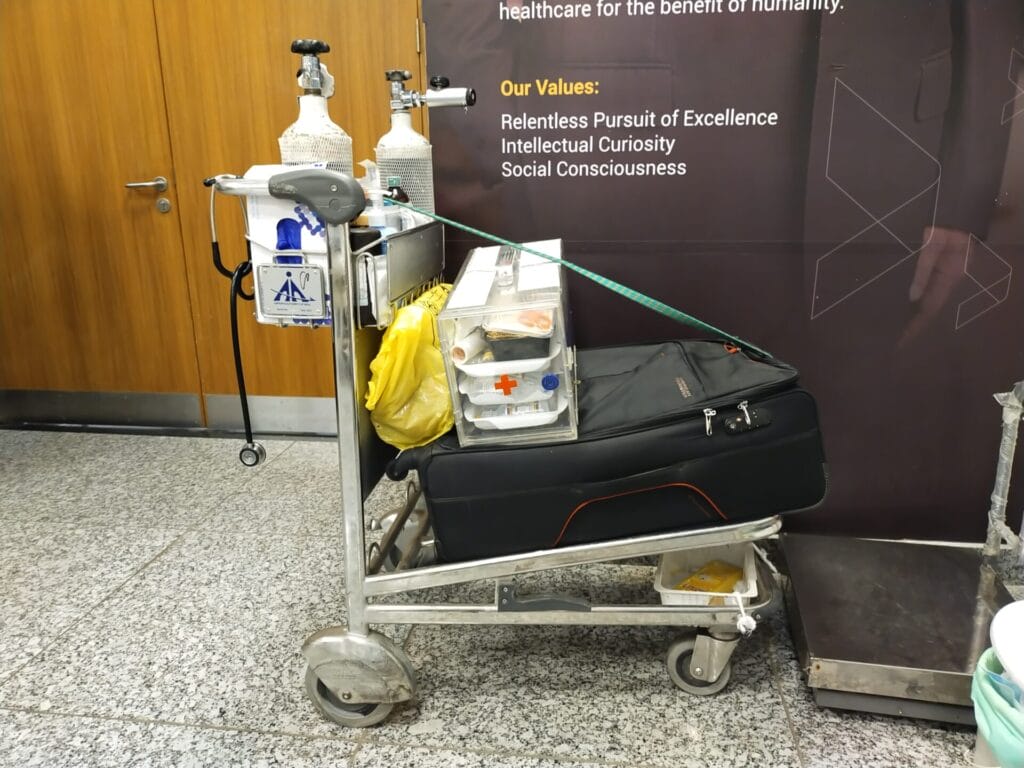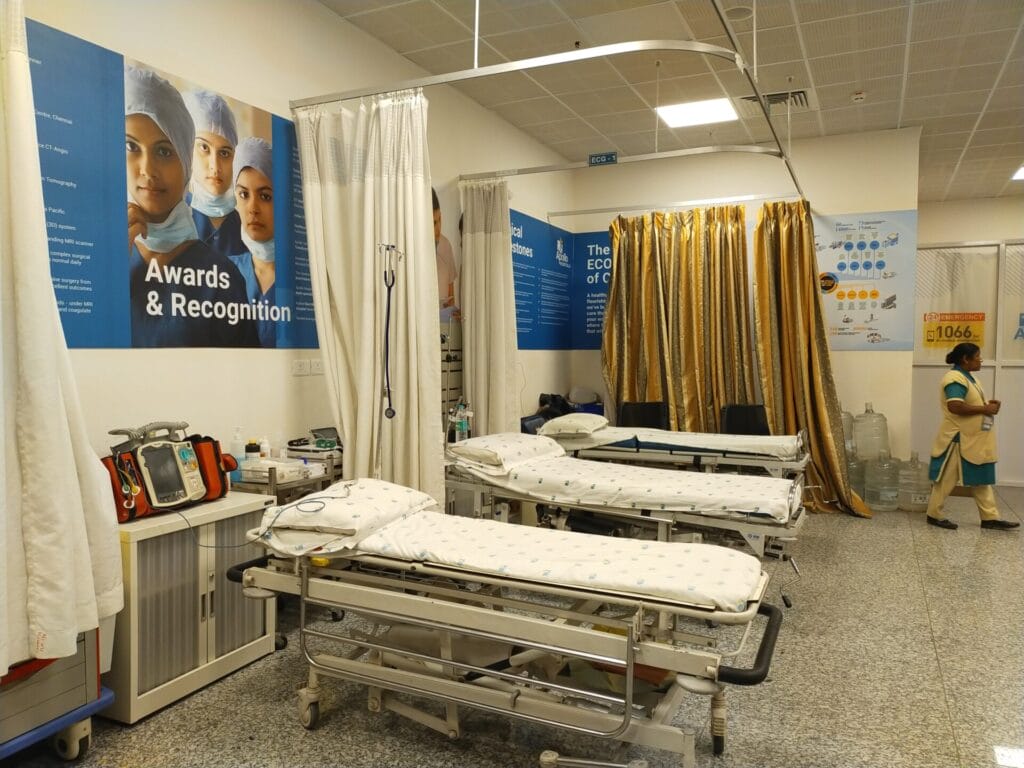In a recent incident, a cab driver who went to drop off passengers at the Chennai International Airport started coughing abnormally. He suddenly vomited blood and collapsed on the driveway. The security guards, who were on duty during that time immediately alerted the medical team at the airport, which did a quick examination and stabilised the patient. He was later sent to the Government General Hospital in Chrompet in the ambulance stationed at the Chennai Airport.
“We not only attend to the emergency medical cases of the passengers inside the terminals but also attend to all such cases in the Chennai airport premises,” says medical staff at the airport. They handle everything from strokes to falls.
Chennai International Airport sees an average footfall of around 58,000 people in a day. Given the need for a medical team to handle emergencies on the premises, the airport has tied up with Apollo Hospitals to provide the required service.
Citizen Matters Chennai has been doing a series of stories on the medical emergency facilities in various transport hubs in Chennai including the Koyambedu bus stand, railway stations, and various metro rail stations. As the last part of this series, we look into the medical emergency facilities available at the Chennai International Airport.
How do the medical emergency centres at Chennai Airport operate?
Chennai International Airport has three emergency centres, one each at each of the terminals that operate round-the-clock, free of cost. Each clinic has one staff nurse, two paramedical staff and one doctor. A small mobile medical centre is also set up within the security check areas. While the clinics look into the cases in arrival and check-in areas, the mobile team attends to cases inside the security area. This apart, there are also three ambulances along with drivers and paramedical staff of Apollo Hospitals deployed at the airport premises.
The helpline numbers of these three centres are displayed for public view inside the terminals. When there is a medical emergency, the respective medical centre gets a call either from the public or from the security guards. “We receive the calls through the landline or the duty mobile. In most cases, the passengers reach out to the nearest security person, airport staff or airline employee and they, in turn, alert the airport manager and emergency medical team immediately,” says the staff at the emergency medical centre in Chennai Airport.
“When we get a call alert about a medical emergency anywhere within the airport, we immediately take the trolley that has all the necessary equipment to attend to such a crisis and rush to the location. The materials in the trolley range from first aid kits to resuscitation devices. The treatment differs for each case. Stabilising the patient is the primary focus,” says Dr Balaji at the emergency medical centre in the international terminal of the Chennai Airport.
Once stabilised, the patient is asked where they prefer to go for further treatment (to a particular private hospital or the nearby government hospital). Depending on the patient’s preference, they are taken to the hospital in the Apollo ambulance. “If the patient chooses to go to a government hospital, the ambulance service is free; for private hospitals a charge is levied based on distance,” he adds.
“This is not a hospital but an emergency medical centre. Within 30 minutes the patient should be stabilised and taken to a full-fledged hospital,” say airport authorities. According to the data received from the office of the Airport Director of Chennai International Airport, the average footfall per month at these centres is 120.
Ramesh G, who has availed the medical service at the emergency medical centre in the domestic terminal says, “I happened to faint at the airport once and the medical team was prompt in attending to me. The medical centre was well-maintained and of high standard.”
Read more: Chennai Metro commuters left in the dark about emergency medical facilities at stations
Facilities available
The medical emergency centres at the Chennai Airport see all kinds of cases ranging from cardiac-related problems to strokes, injuries, fever, cough and cold. Seizures are the most common. “The patients may be exhausted or have a medical history that leads to seizures. Unlike the emergency medical centres in other transport hubs, we see more seizure cases in the Chennai airport,” Dr Balaji adds.
These medical hubs have all the equipment needed for stabilising the patients including defibrillators for Cardiopulmonary Resuscitation (CPR), multipara monitors, oxygen cylinders and incubating facilities.
“The highest level of emergency cases we get here are the ones with the need for resuscitation and we have a strong team that is Advanced Cardiovascular Life Support (ACLS)-certified. The worst-case scenario is a cardiac arrest, which we are equipped to handle effectively,” he assures.
Challenges in operating the medical emergency centre at Chennai Airport
The nature of medical emergencies differ for every transport hub. According to CV Deepak, the Airport Director of Chennai International Airport, “Providing medical service to passengers travelling alone, in case of heart attack or stroke without knowing their medical history, is a challenge.”
No two passengers are the same. They may be from different ethnicities, backgrounds, social strata and age groups. “If a passenger cannot communicate in Tamil, English or Hindi, deciding on a medical procedure becomes a constraint for us. We have to use sign language or get interpreters to communicate in such cases,” says Dr Balaji.
Dr Balaji explains this further: “Passengers with prior ailments travelling alone pose a big challenge because if they are suddenly taken ill, there are no attendants to explain their situation. It’s worse if it’s an international passenger. We won’t know their language, who to contact from the patient’s side or their medical history. Private hospitals usually refuse to take unaccompanied patients. If such patients are not stable enough, we refer them to the nearby government hospital and the 108 ambulances will take them there. The 108 staff will also alert the police department, which will track the patient’s family.”
In some instances, there may be no time to shift the patient to the clinic and treatment has to be given on the spot. “Administering treatment in front of the public is a challenging task. Some among the public might also take videos of the doctors/staff treating the patient. Some may pass some comments. We have to be composed during such times,” he notes.
Read more: Facing a medical emergency in Chennai railway stations? Here is what you should know
What bystanders can do in case of medical emergencies
“Irrespective of the availability of a clinic or an ambulance, the critical first few minutes influence the patient’s survival. It could be a fall or a cardiac arrest. There is a scope for the layperson, who is around the patient when they face such an emergency, to do the right things that will have a major impact on their survival. Even if it is not a life-threatening situation, this immediate response will have an impact on how soon the person can come back to normal,” says Rajesh R Trivedi, the Co-Founder and Managing Trustee of Alert, a not-for-profit organization working to ensure the ‘Right to Life’ by bettering the emergency response ecosystem.
“It starts from the ability to read the emergency scene where one knows if the medical emergency of the person suffering is life-threatening or not and how much time they have before the professional help arrives. With that knowledge, they can do a range of things from tying a bandage if someone is bleeding to putting a person in a simple recovery position, depending on the need. Any layperson can do this and it does not require a paramedic or a doctor,” adds Rajesh.
Many people hesitate to come forward to help because of two reasons — low confidence stemming from a lack of awareness of the first response; and the fear of dealing with the police or court at a later point in time if something goes wrong.
There is something called a Good Samaritan Law which protects the citizens who come forward with good intentions to help during such emergencies. It clearly gives total protection from the police, the provisions to not disclose the identity, and reprieve from any civil or criminal liability even if something goes wrong.
Awareness of these laws will help the common person to come forward with confidence to help those in need of help during medical emergencies. However, it also requires proper awareness of the fundamentals of first responses.
Things to consider during a medical emergency:
Are you dealing with a victim who is conscious or unconscious?
- A simple way to ascertain this is by tapping the shoulders of the victim and shouting something loud. This will help to see if the person responds to stimuli of touch or sound. If there is a response from the person, then they are in a less life-threatening situation but you have to be around to keep them engaged.
- If someone collapses, the first respondent should check if the person is breathing or not. A quick way to do this is by placing a tissue paper (though unscientific, it is an easy way) or two fingers near the nose.
- If the person is breathing, then the immediate thing to do is to put them in a recovery position. In lay person’s terms, it is to put the person in a sideways sleeping position without a pillow. This is extremely helpful in dealing with patients who are breathing but are unconscious.
- Irrespective of the cause of unconsciousness, the recovery position helps to get the blood to the brain. Many a time, when the person is put in a recovery position for five to seven minutes, they will come around immediately.
What not to do?
- A common mistake we tend to make is to provide the unconscious person with water, soda or juice. When a person is unconscious and is not in a position to swallow their saliva, it means that the food pipe is closed and the windpipe is open. When we offer water, soda or any such liquid, the chances of it getting into the person’s lungs are higher.
Alert also provides a basic programme online on first response during medical emergencies every Saturday which is free for anyone to join – https://alert.ngo/savioursaturdays/
They also have YouTube videos of some of the basic first responses that we should be aware of – https://youtube.com/playlist?list=PL0IvZh9fuI9ToFWFbDbz849-uCKQAzZ-K
Having visited the emergency medical centres in Koyambedu bus stand, railway stations in Chennai and the ones at the Chennai Airport, I find the centres at the airport to be of high standard compared to the ones in the other two transport hubs despite Apollo Hospitals providing the service in all three hubs. While these emergency medical centres play a vital role in providing basic life support systems at these significant public places, it is also important to ensure a standard in the quality of the service at all hubs.
Similarly, all the emergency medical centres, including the ones in the Chennai airport, have few staff to run the centres. While the number of staff may be adequate to handle patients on lean days, it may not be enough when there are many cases. Deploying more staff will only reduce the workload of existing staff and help in enhancing the quality of medical service provided.

